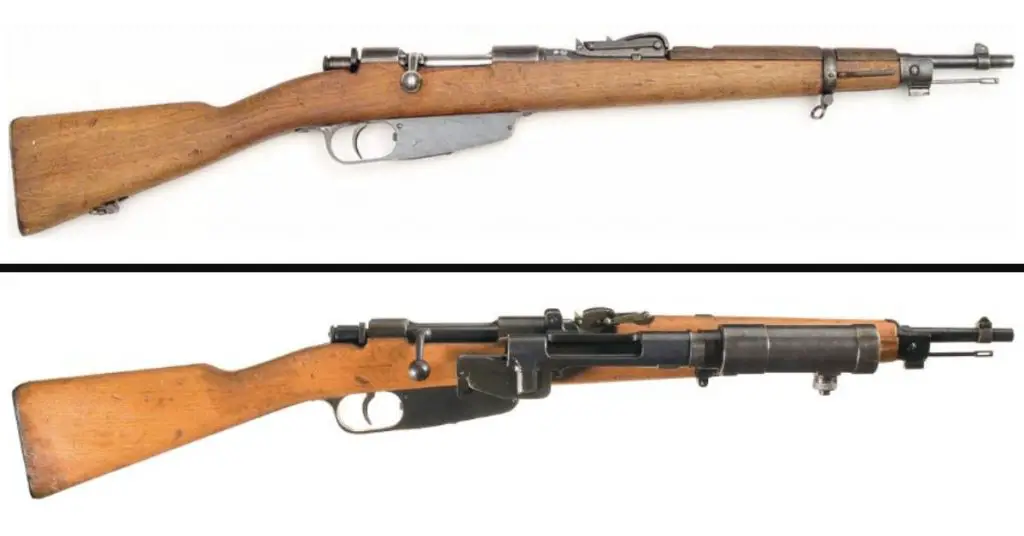The Carcano bolt action rifle was a series of rifles used by the Italian armed forces. The rifle originated in 1891 and used predominately by the Regio Esercito during World War Two.
Origin
In the late 1880s, following new technological developments in the field of small arms such as smokeless powder, arms factories started designing new and smaller cartridge types. In 1890, the Italian army adopted the new 6.35x52mm mannlicher carcano cartridge. However, this new cartridge required the development of a new infantry rifle, given that the Army’s old Vetterli Vitali rifles implemented 10.35x47mm cartridges.
Turin Arms factory Engineer Salvatore Carcano developed the new weapon in collaboration with General Giacomo Paravicino from the Terni Arsenal. The resulting gun was a 1.28m long rifle mounting a modified Mauser bolt action system and an adjustable sight. The fixed notched distance was good for up to 300 m, with an adjustable site for targets between 450-2,000 meters. The design became finalized in 1891 as the Modello 91 (M91), or the novantuno. Outside of Italy, it is known as the Manlicher Carcano Mod.91, although that nomenclature is incorrect.

M91 Long Rifle – 6.5x52mm. Source: imfdb.org
The Italian army subsequently adopted and mass-produced the rifle in March 1892. The shorter cavalry version (91.9 cm) appeared in 1893. It incorporated a fixed bayonet below the final section of the gun barrel. The “Special Troops” (TS) version of the model 91 came out in 1900. It is slightly shorter than the cavalry version with a classic removable bayonet.

M91 TS and Carabine version. Source: Regio Esercito reenactor.
Abyssinian War, Italo Turkish War and World War I
The new rifle was used in action for the first time during the unsuccessful Italian attempt to subjugate Abyssinia culminating in the disaster at Adua in 1896. The rifle saw action in the Italo Turkish War (1911-1912) and the First World War.
Experiences in the Great War showed the unsuitability of long barrel guns for modern warfare. However, the war impeded the affordability of making massive changes in small arms equipment, so the Regio Esercito delayed the project to shorten the infantry weapon.
Interwar Versions and Cartridge issue
In 1924 the Italian Army decided to shorten their stock of Mod. 91 rifles in 1924. This decision solved the logistical issue of having to field both a long gun and carbine. From this initiative came the Mod. 91/24, a 92 cm long rifle, adopted as the standard Italian infantry weapon. In 1928 further modifications led to the realization of the Mod.91/28 Tromboncino, which mounted a grenade launcher on the side of the gun.

Mod.91/24 and Mod.91/28 Tromboncino. Source: imfdb.org.
The experience of the second Italo-Abyssinian war (1935-1936) raised concerns about the ballistic effectiveness of the outdated Mod. 91 cartridges. For instance, critics claimed the 6.5x52mm ammunition did not produce enough stopping power. As a result, a new rifle version emerged using a more powerful 7.35x51mm ammunition. The Army soon adopted it into the force. From this initiative, the Mod.38 was born. As a result, it utilized more powerful ammunition and a fixed sight calibrated for shooting targets within 300m. The short, compact weapon was 102cm long. Production started while older stocks of Mod.91 were re-chambered to fit the new cartridge.

Carcano m38. Image: Public domain.
World War Two
In 1940 the Army realized the lack of availability of the 7.35x51mm. Additionally, Italy’s industrial apparatus cannot complete the full conversion/replacement of new rifles fitting the 7.35 caliber in a satisfactory time. Given the full availability of 6.5 ammo stocks, the Regio Esercito decided to use the older 6.5 Carcano ammo.
This reversal produced a logistical nightmare and worsened an already unfavorable situation. As a result, this shift in wartime production meant two versions saw concurrent use in World War 2. In some cases, frontline 7.35mm rifles were returned and replaced with proven, albeit less effective, 6.5mm rifles. However, the production of Mod.38 rifles ceased after 285,000 units. As a result, these guns were placed in storage or given to the fascist militia (MVSN).

Mod.91/38. Source: imfdb.org.
The rifle was produced in five calibers during its service history:
- 6.5×52: (M91’s, and the submodels M91/24, M91/28, M91/38, M91/41))
- 7.35×51: (M38 only)
- 7.92×57: IS Mauser (M38 S and German Army Conversions)
- 6.5×50: Japanese (Tipo I only)
- 6.5×54: MS Greek (Austrian rechambered WW I capture guns)
Carcano Rifle Design Improvements
The Mod.38 design improvements became incorporated in the new Mod.91/38 firing older 6.5 ammunitions. This rifle became the standard infantry weapon of the Italian Army in World Wart Two. Furthermore, like its predecessors, it also came in a cavalry (carabine) version. However, this robust and reliable rifle used low quality of ammunition. Because of that, its reputation suffered in the years to come. The first production initiated out refitted older weapons.

M91/41. Source: imfdb.org
A new specially designed version debut in 1941 specifically designed for Alpine troops destined to fight on the Eastern front. This version, the Mod.91/41, resembled the original rifle. However, it was longer than the “short” versions (117cm) and reintroduced the adjustable sight for targets up to 1,000 meters.
Post World War Two
After WW2, these rifles remained in the weapons inventory of the Italian army until 1959. Italian police utilized the Tromboncino to fire smoke grenades until the early 1990s.

Mannlicher-Carcano Rifle Owned by Lee Harvey Oswald. Image: Public domain.
On 22 November 1963, Lee Harvey Oswald used a scoped version of the Carcano mod. 91/38 to assassinate U.S. President John F. Kennedy.
Sources
militaryfactory.com (2019).
extraordinanza.net (2005).
forgottenweapons.com (2017).
